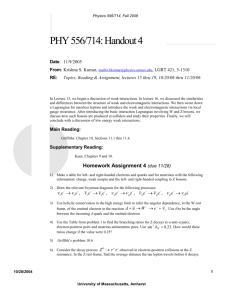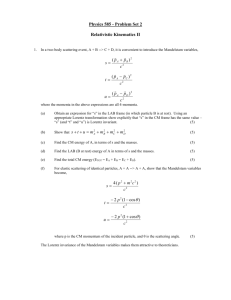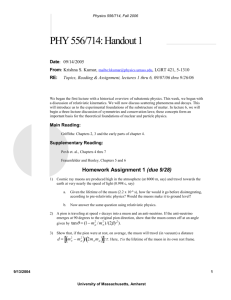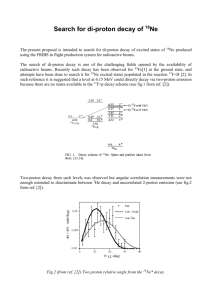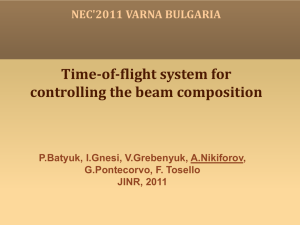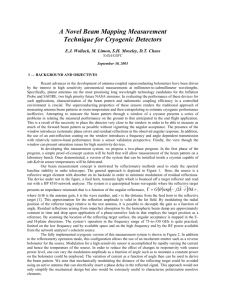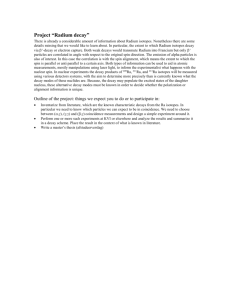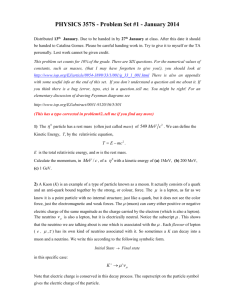Abstract PEN-MEG
advertisement
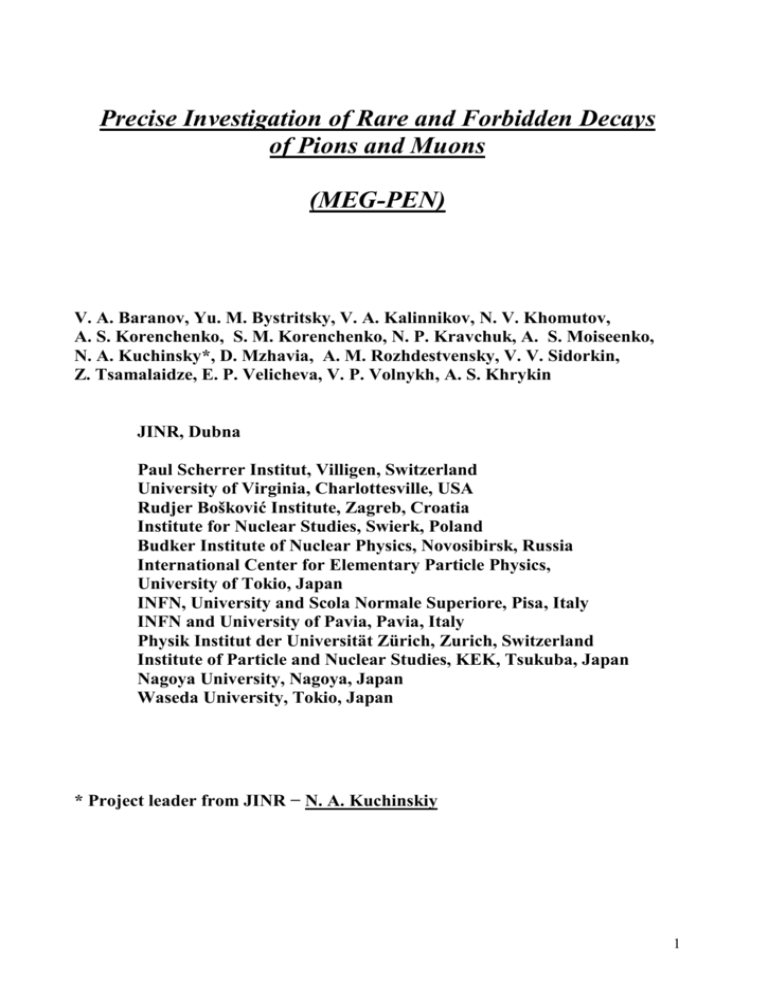
Precise Investigation of Rare and Forbidden Decays of Pions and Muons (MEG-PEN) V. A. Baranov, Yu. M. Bystritsky, V. A. Kalinnikov, N. V. Khomutov, A. S. Korenchenko, S. M. Korenchenko, N. P. Kravchuk, A. S. Moiseenko, N. A. Kuchinsky*, D. Mzhavia, A. M. Rozhdestvensky, V. V. Sidorkin, Z. Tsamalaidze, E. P. Velicheva, V. P. Volnykh, A. S. Khrykin JINR, Dubna Paul Scherrer Institut, Villigen, Switzerland University of Virginia, Charlottesville, USA Rudjer Bošković Institute, Zagreb, Croatia Institute for Nuclear Studies, Swierk, Poland Budker Institute of Nuclear Physics, Novosibirsk, Russia International Center for Elementary Particle Physics, University of Tokio, Japan INFN, University and Scola Normale Superiore, Pisa, Italy INFN and University of Pavia, Pavia, Italy Physik Institut der Universität Zürich, Zurich, Switzerland Institute of Particle and Nuclear Studies, KEK, Tsukuba, Japan Nagoya University, Nagoya, Japan Waseda University, Tokio, Japan * Project leader from JINR − N. A. Kuchinskiy 1 We are proposing a new precise measurement of the π → eν decay branching ratio with a relative uncertainty of 0.05-0.1%. The current world average gives the experimental ratio [4] Re/μexp = [Г(π+→е+ν) / Г(π+→μ+ν)]exp = (1.230 ± 0.004) × 10-4 . Historically, this ratio of pion decay rates provided one of the key confirmations of the V-A nature of the electroweak interaction and of the electron-muon (μ-е) universality. It is therefore not surprising that practically all modern textbooks on subatomic physics continue to treat the π→ℓνℓ decay in detail at the tree level. On the other hand, experimental results lag in precision behind the standard model (SM) calculations by about an order of magnitude. A search for possible limitations of the SM is one of the most important tasks of modern particle physics. Our goal is to improve the accuracy of the Re/μexp measurement also by about an order of magnitude what would provide a useful crosscheck of SM predictions. It should be noted that experimentally detected decays are usually not pure π→ℓνℓ decays but contain also some quantity of radiative π→ℓνℓγ decays. The proposed measurements will be performed at PSI using the PIBETA detector system that includes a spherical 4π-calorimeter made of pure CSI crystals, thin-wall cylindrical multiwire proportional chambers and a plastic scintillator hodoscope. The experiment will be conducted in collaboration with scientists from Georgia, Switzerland, USA, Croatia and Poland. The π→ℓνℓ decays are very precisely described in the SM theoretical framework. Furthermore, higher-order contributions to the process are so well controlled that the ratio can be calculated with the highest accuracy of any allowed meson decay. The two most recent standard model calculations give, respectively, Re/μSM = [Г(π+→е+ ν (γ)) / Г(π+→μ+ ν (γ))]calc = (1.2352 ± 0.0005) × 10-4 [1] Re/μSM = [Г(π+→е+ ν (γ)) / Г(π+→μ+ ν (γ))]calc = (1.2356 ± 0.0001) × 10-4 [2]. These authors have demonstrated that the π+→е+ν branching ratio is theoretically understood at the level of (∆R/R)e/μSM ≤ 4×10-4. Subsequently, in [3] radiative contributions to π+→е+νγ decay at the 0.1% level has been discussed. Experimental tests of lepton universality provide a useful crosscheck of SM predictions, as well as potentially useful independent limits on masses and couplings of certain particles outside of the SM. Rapid developments in the neutrino sector in recent years have renewed the interest in lepton universality. In conclusion, the large discrepancy between the theoretical and experimental accuracy provides a strong motivation for a new precise measurement of the π+→е+ν branching ratio. The measurement discussed in this proposal is a continuation of a program of precise measurements of rare pion and muon decays using the PIBETA detector system [5] at PSI “meson factory”. The PIBETA detector has been awarded the first prize of JINR in 2003. The π→е+υе decay branching ratio is by 3-4 orders of magnitude higher than those of + π →π0е+υ and π+→е+υ decays already studied with a high precision by the authors. It is a reason why we plan to use the following approach: Pion stop rate in the target will be about 20000 s-1. At such stop rate, muon pileup in the target is negligible. Successive pions are separated on average by 50 μs, or almost 23 muon lifetimes, resulting in muon pileup probability of just over 10-10. 2 The pion beam momentum will be reduced from 115 MeV/c to ~ 75 MeV/c. Pion beam tunes with momentum in the range 65-80 MeV/c were developed and successfully tested in the October 2005 πE1 area beam development run. At the pion energy reduced from ~ 40 MeV to ~ 20 MeV, the cross section of nuclear reactions (pion single charge exchange and pion absorption induced events) and the respective prompt background rate also will be reduced by more than an order of magnitude. Using a low beam momentum results in several advantages: (a) reduced thickness of the active degrader detector, with the accompanying reduction in prompt hadronic events, and (b) reduction of the pion stop energy deposition in the target to levels comparable with the π+→μ+υμ signal, ~ 4 MeV. The latter feature enhances the reliability of discrimination of π→е from π→μ→е event sequences in the target. A new 2-GHz 10-bit waveform digitizer will be implemented for the active target, active degrader and beam counters. With proper care in the final target detector design, and by using a fast waveform digitizer, we expect no problems meeting the requirement on π+→μ+υμ(γ) decay event identification. The new trigger electronics is being developed to integrate the new waveform digitizer, as well as ensure low deadtime with the planned pion stopping rates and increased event data size. Data processing and analysis will be made independently in USA and JINR. JINR: - 220 cristals pure CsI. - MWPC’s with read-out electronics - Beam TPC - Data acquisition. - Data processing and analysis. We also propose to search for a lepton number non-conservation in the µ+→е+γ decay with a relative sensitivity of 10-14. The experiment will be conducted at PSI, using the πЕ5 beam, the most intense continuous “surface” muon beam presently available in the world. A completely new detector with the best possible positron and photon energy resolution is necessary to reach the planned experimental sensitivity. In the SM, lepton flavor is preserved because of the vanishing neutrino masses. The SM can be quite easily extended to include the neutrino mass pattern observed in recent neutrino oscillation experiments. Yet lepton flavor violation outside the neutrino sector is extremely small. Fundamental theories such as supersymmetric unification predict that µ+→е+γ should occur with a decay branching ration that should be above 10-14. This experiment has therefore a real chance of making a discovery, which would provide very clear evidence for new physics beyond the standard model. Even a non-observation of the decay at the foreseen level of sensitivity would place a stringent constraint on these theories and on the general nature of the new physics, and will thus be of crucial importance in pointing out the future directions of particle physics. The sensitivity level of 10-14 would be an improvement of almost three orders of magnitude with respect to the present best limit set by the MEGA experiment [6]. In the framework of the theories mentioned above, our sensitivity to µ+→е+γ corresponds [7] to a sensitivity of 2.5×10-17 on the µ – е convertion process with an aluminum target, slightly above that the proposed MECO experiment aims to reach [8]. A schematic view of the detector is shown in Fig. 2. A positron spectrometer and a photon calorimeter are the main parts of the experimental setup. A quasi-solenoidal magnetic field in the spectrometer is shaped so that monochromatic positrons from the target follow trajectories with constant projected bending radius, independent of the emission angle over a wide angular range. This allows a defined window on the absolute positron momentum to be set for detection by the 3 drift chamber cells placed at the outermost radii, thereby significantly reducing the accidental pile-up of Michel positrons. Simulation shows the expected FWHM resolution of ~ 0.7-0.9% for the positron momentum and of ~ 9-12 mrad for the angle with a registration efficiency e = 0.95 covering ten percent of the solid angle. While all positrons are confined inside the magnet, the gamma-rays penetrate through the thin superconducting coil of the spectrometer with ~ 80% transmission probability, and are detected by a scintillation detector, which consists of a 0.8 m3 volume of liquid Xenon viewed from all sides by about 800 photomultipliers. Only the scintillaton light is used. Tests on a large scale prototype as well as a full simulation show that one can expect FWHM resolutions of 1.4% for the energy, 4 mm for the position and 0.1 ns for the timing measurements for 52.8 MeV gamma-rays. A “surface” muon beam of ~ 108 s-1 intensity will be used for the experiment. Such high beam intensity along with the unique positron and gamma detectors would allow us to reach the planned sensitivity BR(e) = 0.94×10-14 after a data taking period of 2.2×107 s ( ~ one year) . This project is divided into two stages: 1. The BR sensitivity of 10-13 will be obtained 2. The detector will be upgraded using the experience of the first stage and the planned sensitivity of 10-14 will be reached. JINR: - 0.9 m3 liquid Xe - 17 dift chambes. - Data taking. 1. 2. 3. 4. 5. 6. 7. 8. W. J. Marciano and A. Sirlin, Phys. Rev. Lett., 71, 3629 (1993). R. Decker and M. Finkemeier, Nucl. Phys. B 438, 17 (1995). E.A. Kuraev, JETP Lett. 65, 127 (1997). S. Eidelman et al. (the Particle Data Group), Phys. Lett. B 592, 1 (2004). E.Frlez et al. NIM, A526, 300-347 (2004). http://pibeta.phys.virginia.edu L.M.Brooks et al., MEGA Collaboration, hep-ex/9905013. A.Czarnecki et al., hep-ph/9801218. W.Molzon et al., MECO Collaboration, A Search for μ-N→e-N with sensitivity below 10-16, AGS proposal P940, 1997. 4 Figure 1: Schematic cross section of the PIBETA apparatus showing the main components: beam entry, active degrader (AD) and target (AT) , MWPC's and support, plastic veto detectors (PV) and PMT's, pure CsI calorimeter and PMT's. Figure 2: Schematic view of the μ→еγ detector. 5 Table 1: Historical Progress of search for μ+е+γ since the era of meson factories. Place Year ∆Ее ∆Еγ ∆teγ ∆θev Upper Limit % % ns mrad SIN TRIUMF LANL LANL LANL 1977 1977 1979 1986 1999 8.7 10 8.8 8 1.2 9.3 8.7 8 8 4.5 1.4 6.7 1.9 1.8 1.6 PSI-MEG 2006 0.7 1.4 0.1 37 87 17 8.4 <1.0×10-9 <3.6×10-9 <1.7×10-10 <4.9×10-11 <1.2×10-11 <1.0×10-14 6

